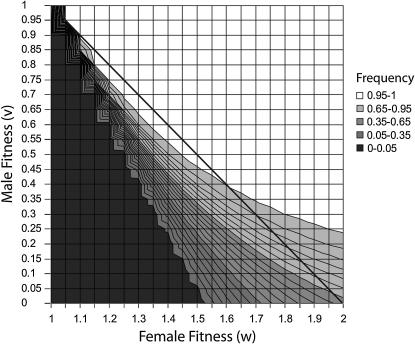Figure 3.—
The frequency of δ after 10,000 generations starting with a = x = 0.01 and assumed dominance. The area below the diagonal line has an autosomal sex-averaged fitness <1. In the interaction described here, δ can rise in frequency and persist in the population over a larger area including when the sex-averaged fitness is lower than that of the non-δ-allele. (Note the jaggedness of the line at a = 0.05 is an artifact of the plotting program.) Also, the p2 and p3 probabilities of winning (game 2, Figure 1A) are related to v and w, respectively. This suggests a convex nature of the winning curve, a necessary condition for Parrondo's games (cf. Figure 14 of Harmer and Abbott 2002).

